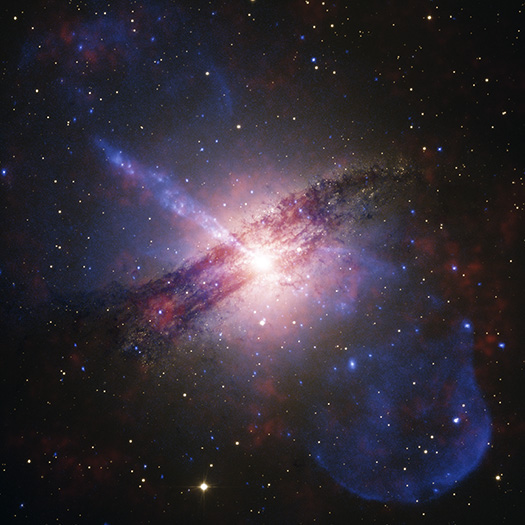Centaurus A Shines in New Image from NASA's Chandra and IXPE

Centaurus A
Credit: X-ray: (IXPE): NASA/MSFC/IXPE/S. Ehlert et al.; (Chandra): NASA/CXC/SAO; Optical: ESO/WFI; Image processing: NASA/CXC/SAO/J.Schmidt
The galaxy Centaurus A (Cen A) shines bright in this image combining data from multiple observatories. In the center of this galaxy is a supermassive black hole feeding off the gas and dust encircling it, and large jets of high-energy particles and other material spewing out. The jet shown at the upper left of this image extends for about 13,000 light-years away from the black hole. Also visible is a dust lane, wrapping around the middle of the galaxy, which may have resulted from a collision with a smaller galaxy millions of years ago.
Colors in this image have been chosen to reflect the sources of data. Blue shows X-ray light captured by NASA’s Chandra X-ray Observatory, orange represents X-rays detected by NASA’s Imaging X-ray Polarimetry Explorer (IXPE) satellite, and optical light seen by the European Southern Observatory in Chile is colored white and gray.
Cen A has been studied extensively since the launch of Chandra in 1999. With IXPE, which launched in 2021, scientists can understand the mysteries of this object in a new way. IXPE is specialized to look at a property of X-ray light called polarization, which relates to the organization of electromagnetic waves. This specialized measurement is helping scientists study how particles become accelerated to high energies and speeds — nearly the speed of light — at extreme cosmic objects like this one.
At Cen A, researchers using IXPE seek to understand what causes the X-ray emission in the jets. So far, scientists have not detected X-ray polarization at Cen A, indicating that particles much heavier than electrons, such as protons, are not producing the X-rays. More insights are to come as scientists analyze the data.
Cen A is found 12 million light-years from Earth in the constellation Centaurus and represents the fifth brightest galaxy in the sky.
Category:
- Log in to post comments
